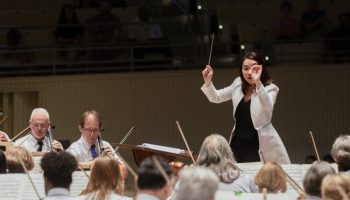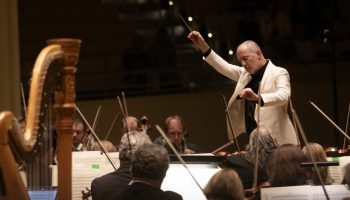Overture to The Creatures of Prometheus, op. 43
Ludwig van Beethoven
One of history’s pivotal composers, Ludwig van Beethoven was born on Dec. 15 or 16, 1770, in Bonn, Germany, and died in Vienna, Austria, on March 26, 1827. His overture to the ballet, The Creatures of Prometheus (Die Geschöpfe des Prometheus), was one of the composer’s early successes in the sphere of public performances after his move to Vienna from his native Bonn. Based upon a libretto by Salvatore Viganò, who was also a dancer, its premiere took place in the Burgtheater on March 28, 1801, and went on to enjoy more than 20 performances. The work is dedicated to Maria Christiane Fürstin von Lichnowsky. The Overture is scored for two flutes, two oboes, two clarinets, two bassoons, three horns, two trumpets, timpani and strings.
Beethoven wrote only one complete ballet score, the product of his early years in Vienna. The commission offered him the opportunity to try out orchestral effects that proved useful as he continued turning his attention to the composition of symphonies. The first chords we hear in the introduction to his Symphony no. 1, Op. 21, which had its premiere in 1800, are reused in the Adagio opening of the Overture to The Creatures of Prometheus. The music for the ballet itself includes a thunderstorm in its opening scene, and in that we can hear in this the origins of Beethoven’s even more effective storm in his Pastoral Symphony. More to the point regarding tonight’s program by the Chautauqua Symphony Orchestra, the ballet’s finale incorporates an English-style contradance that forms the basis for the finale of the Eroica Symphony. The original scenario for Viganò’s ballet is lost, but as a note in the program describes the title character as “an exalted spirit, who found the humans of his time in a condition of ignorance, refined them through science and art, and brought to them civilized manners, customs, and morals. … Two statues have been brought to life and introduced into this ballet, and those, through the power of harmony, are made sensible to the passions of human life. Prometheus leads them to Parnassus so that Apollo, god of the arts, might enlighten them. Apollo gives them Amphion, Arion and Orpheus to instruct them in music; Melpomene to teach them tragedy; Thalia, comedy; Terpsichore and Pan, the dance of shepherds; and Bacchus, the heroic dance.” The work, in short, reflects ideals consistent with those associated with the Enlightenment (Aufklärung), a movement with which Beethoven had great empathy. More specifically, the idea of the arts as humanizing agent was one articulated most powerfully by Friedrich Schiller in his Letters on the Aesthetic Education of Man, published in 1794. As we know, Schiller again loomed large in Beethoven’s thinking in his setting of this poet’s An die Freude (Ode to Joy) in the finale of his Ninth Symphony. Indeed, Beethoven (along with many other composers) were drawn to Schiller’s poem soon after its publication in 1786, and Beethoven’s earliest ideas for his setting stem from the 1790s, even though they did not achieve fruition until 1824.
After the introduction to the Overture to The Creatures of Prometheus, with its surprising opening chord and noble oboe theme, the tempo shifts to an Allegro molto e con brio, which rushes along with tremendous energy, following the traditional structure of sonata form but filled with early signs of the audacity which form the hallmark of the Beethoven of the Eroica Symphony, such as bold syncopations (off-beat accents).
Concerto No. 3 for Piano and Orchestra, op. 26
Sergei Prokofiev
Sergei Prokofiev, one of the 20th century’s leading composers, was born in Sontsovka, Ukraine, on April 23, 1891, a date that fell near the end of the era of Tsarist rule. It is one of history’s greatest ironies that Prokofiev died on March 5, 1953, the same day as the Communist dictator, Joseph Stalin. His Third Piano Concerto was composed and received its first performance in Chicago on Dec. 16, 1921, with the composer as soloist and Frederick Stock conducting the Chicago Symphony Orchestra. It is scored for two flutes, piccolo, two oboes, two clarinets, two bassoons, four horns, two trumpets, three trombones, timpani, percussion (bass drum, castanets, tambourine, and cymbals) and strings.
First performed in Chicago on Dec. 16, 1921, with the composer as soloist and Frederick Stock conducting the Chicago Symphony Orchestra, Prokofiev’s Third Piano Concerto has emerged as one of the most popular works of its kind written in this century. The reasons for that popularity are evident enough to anyone who has heard the work and has admired its immense energy, brilliant virtuosity, wit and sweeping lyricism. Of the five concertos for piano penned by the Russian master, this is the most frequently performed. Although it received its premiere in 1921, the Third Piano Concerto contains musical ideas that Prokofiev conceived as early as 1911. One of the motoric themes from the first movement’s Allegro comes from that year. The theme from the second movement was written in 1913, and two of its variations were composed in 1916-17. Two themes from Allegro ma non troppo finale come from a discarded Quartet dating from 1918. Despite its fragmented genesis, the Third Piano Concerto emerges as a wholly integrated work that manages successfully to retain certain thematic links among its three movements. The composer spent the better part of the summer of 1921 in Brittany forging the final version of the composition.
The first movement, Andante-Allegro, contains a wealth of melodic ideas — now lyrical, now driven as a perpetual motion. The general tonal cast is that of its home key of C major, in keeping with Prokofiev’s preference for writing in a clearly tonal idiom and eschewing the atonal tendencies of his contemporaries. The second movement is labeled Tema con variazioni. Its gently martial theme is followed by five variations with a coda that brings the theme back in a new orchestration with the soloist in an accompanying role. A striking formula punctuates the final cadence of the theme as well as each of its variations, giving the audience a clear signpost of the movement’s form. The finale is a whirling, waltz-like affair that balances the wealth of themes found in the opening movement with an impressive amalgamation of its own thematic ideas. Clarity of formal design, a hallmark of Prokofiev’s style, is everywhere apparent throughout this masterly work.
Symphony No. 3 in E-flat Major, op. 55 (“Eroica”)
Ludwig van Beethoven
Beethoven’s epic and groundbreaking Symphony no. 3 (“Eroica”) was composed in 1804 and received its first public performance at Vienna’s Theater an der Wien on April 7, 1805. The “Eroica” is dedicated to Prince Franz Joseph von Lobkowitz, in whose palace it received its first private reading in front of a select audience. The symphony is scored for two flutes, two oboes, two clarinets, two bassoons, three horns, two trumpets, timpani and strings.
Beethoven had what might be characterized as a love-hate relationship with the dominant political figure of his day — Napoleon Bonaparte. The violent erasure of the French leader’s name from the title page of the “Eroica” Symphony stands as silent witness to the composer’s reaction to Napoleon having crowned himself Emperor in 1804. Scholars such as Frida Knight and Maynard Solomon have observed that Beethoven’s public rejection of Napoleon signified more than a tempestuous artist’s reaction to a tyrant. It represented his psychological alignment with Austrian nationalism and Enlightenment humanism. Beethoven’s plan, in short, was to match political power with artistic power. The “Eroica” Symphony, therefore, was the first shot to be fired in this battle.
Those political issues, however, came later. Many of the musical influences that shaped the “Eroica” Symphony were undeniably French in origin. Post-1789 France cultivated an impressive repertoire of “heroic” music, much of which was composed to honor the memory of the Revolution’s fallen heroes and martyrs. The composers of these pieces — Gossec, Grétry, Méhul and Cherubini — were well-known figures to Beethoven. Important features of their works were muffled funeral drums and hymn-like melodies, elements that Beethoven freely incorporated in the “Eroica” second movement: the Marcia funèbre (the same influence may also be seen in the slow movement of his Piano Sonata in A-flat, op. 26). The chief glory of the “Eroica” Symphony lies in its synthesis of the spirit of the French revolutionary style with the formalities of the four-movement symphony to create a work of unparalleled and unprecedented scope and power.
The sheer length of the “Eroica” — nearly twice that of Beethoven’s first two symphonies — is only the outward manifestation of its immense scope. Beethoven was well aware that such expansion entailed a certain degree of risk taking. That is why the first edition of the score and parts for the “Eroica” included a recommendation to place the piece “nearer the beginning than the end” of a concert, lest the audience become “fatigued by the previous pieces.” It is useful to remember, however, that it was not unusual for a concert in Beethoven’s day to last much longer than the traditional length of concerts nowadays. But given our modern age of television and the internet, our attention span seems to be shrinking. Too bad, because the events of this powerful work more than amply reward our closest powers of concentration.
The scenario that is played out in the opening movement, Allegro con brio, is akin to a French “rescue drama,” which is a kind of Fidelio without words in which we sense both peril and exultation to the fullest extent. Similarly, the Marcia funèbre is written on a huge scale. That movement is filled with dramatic gestures, none more explosive than the suspense-filled moment whereby a single note in the violins hangs quietly in the air, only to be severed by a fortissimo guillotine blow of cellos and basses. The last two movements also live up to the Eroica’s grand scale. No classical minuet will suffice here.
Instead, Beethoven substitutes a truly explosive scherzo, a movement that lives up to its name (“joke”) through audacious rhythmic and metric trickery. Even the humble trio section is raised to a higher level of drama by means of a stirring trio of horns. The finale, Allegro molto, is based on a tune that Beethoven had used in three previous works — the seventh of 12 Contradanses, WoO 14; the finale of the ballet, The Creatures of Prometheus op. 49; and the Variations for Piano, op. 35 (often erroneously referred to as the Eroica Variations). A feature of the latter work — variations on the tune’s bass line before the entry of the tune itself — is retained in the “Eroica” finale. Beethoven, in this final movement, took a giant stride toward redefining the significance of the last movement of a symphony, a part of the sonata cycle that heretofore (except, perhaps, in Mozart’s “Jupiter” Symphony) had been given far less weight than the first or second movement. Recent research by Lewis Lockwood and Alan Gosman on Beethoven’s sketchbook, known to scholars as Landsberg 6, or simply the “Eroica” Sketchbook, shows not only that Beethoven’s concept for the entire symphony began with the work’s finale, but that even as early as 1802, Beethoven had started jotting ideas that would find their way into the Fifth and Sixth Symphonies. An elegant facsimile, transcription, and editorial comments on Landsberg 6 by Lockwood and Gosman was published in 2013 by the University of Illinois Press.
David B. Levy is professor of music at Wake Forest University in Winston-Salem, North Carolina.





